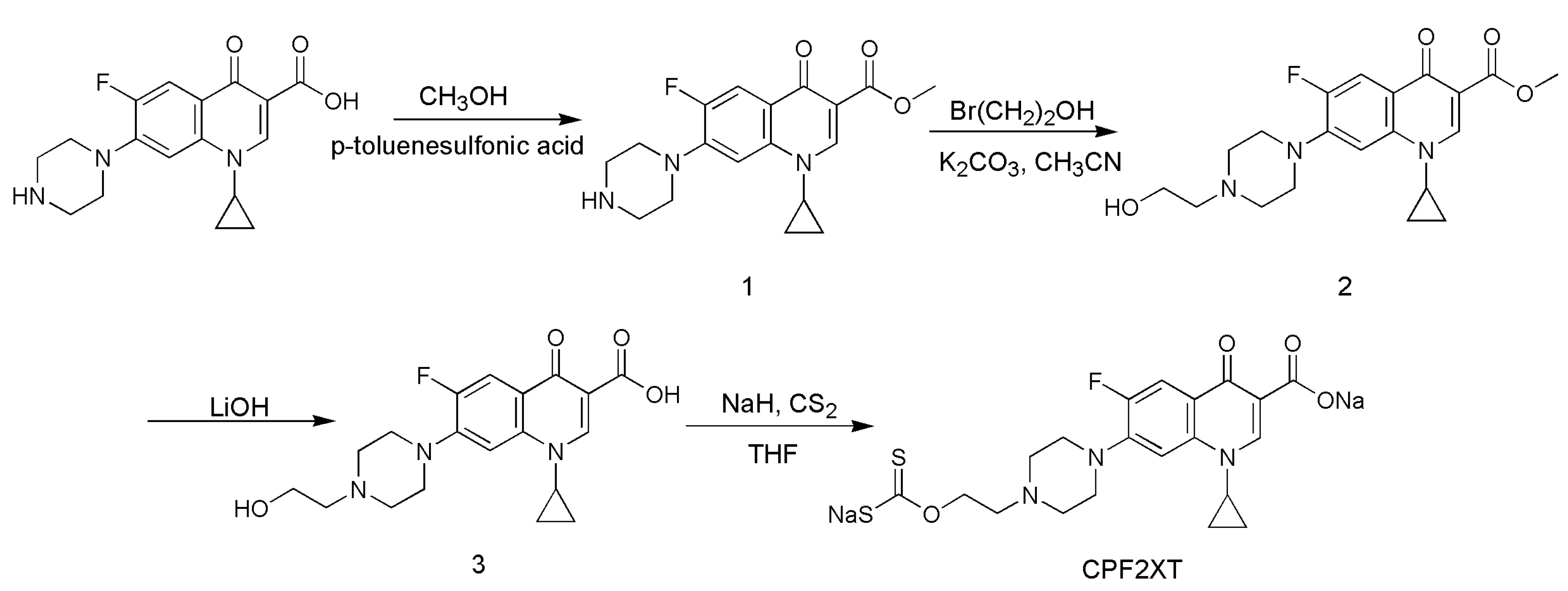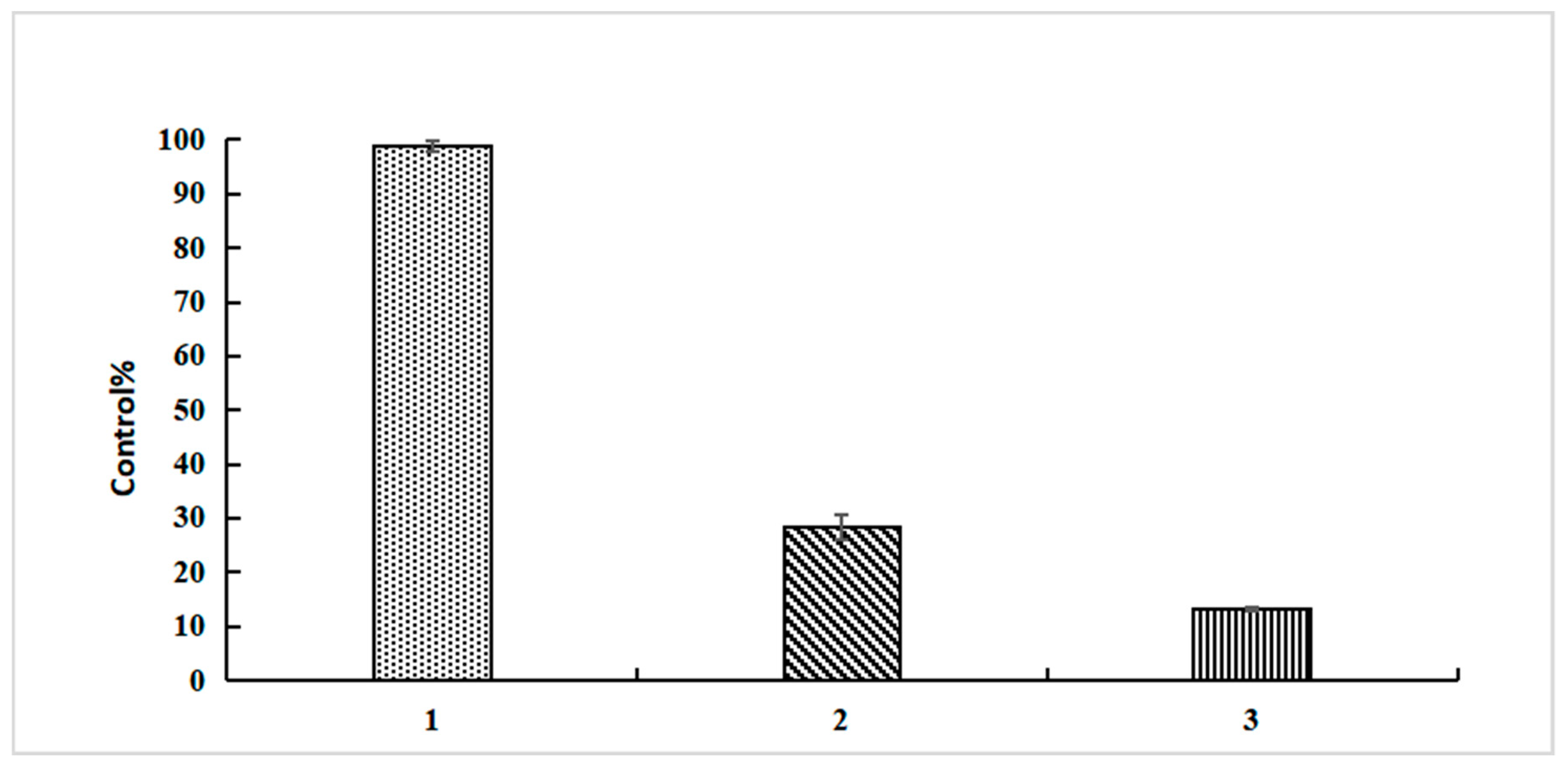Design, Preparation, and Evaluation of a Novel 99mTcN Complex of Ciprofloxacin Xanthate as a Potential Bacterial Infection Imaging Agent
Abstract
1. Introduction
2. Results
2.1. Synthesis
2.2. Radiolabeling
2.3. Physicochemical Properties Evaluation
2.3.1. Stability Tests
2.3.2. Partition Coefficient
2.4. In Vitro Binding of 99mTcN-CPF2XT with Bacteria
2.5. Biodistribution
3. Discussion
4. Materials and Methods
4.1. Synthesis of CPF2XT
4.2. Radiolabeling of 99mTcN-CPF2XT and Quality Control Assay
4.3. Stability Study
4.4. Partition Coefficient Measurement
4.5. In Vitro Bacteria Binding Study
4.6. Biodistribution Study in Bacterial Infected Mice
4.7. Biodistribution Study in Turpentine-Induced Abscess Mice
5. Conclusions
Author Contributions
Funding
Conflicts of Interest
References
- Mirshojaei, S.F. Advances in infectious foci imaging using 99mTc radiolabelled antibiotics. J. Radioanal. Nucl. Chem. 2015, 304, 975–988. [Google Scholar] [CrossRef]
- Mota, F.; Ordonez, A.A.; Firth, G.; Ruiz-Bedoya, C.A.; Ma, M.T.; Jain, S.K. Radiotracer development for bacterial imaging. J. Med. Chem. 2020, 63, 1964–1977. [Google Scholar] [CrossRef] [PubMed]
- Hall, A.V.; Solanki, K.K.; Vinjamuri, S.; Britton, K.E.; Das, S.S. Evaluation of the efficacy of 99mTc-Infecton, a novel agent for detecting sites of infection. J. Clin. Pathol. 1998, 51, 215–219. [Google Scholar] [CrossRef] [PubMed]
- Jain, S.K. The promise of molecular imaging in the study and treatment of infectious diseases. Mol. Imaging Biol. 2017, 19, 341–347. [Google Scholar] [CrossRef] [PubMed]
- Becker, W.; Meller, J. The role of nuclear medicine in infection and inflammation. Lancet Infect. Dis. 2001, 1, 326–333. [Google Scholar] [CrossRef]
- Changizi, V.; Takavar, A.; Babakhani, A.; Sohrabi, M. Scatter correction for heart SPECT images using TEW method. J. Appl. Clin. Med. Phys. 2008, 9, 136–140. [Google Scholar] [CrossRef]
- Uyaroglu, O.; Demiroglu, H.; Topal, G.; Parlak, Y.; Gumuser, F.G.; Turkoz, E.U.; Demir, V.; Ates, B.; Unak, P.; Avcibasi, U. Radiosynthesis and biodistribution of 99mTc-Sulfamethoxazole: A novel molecule for in-vivo infection imaging. Med. Chem. Res. 2017, 26, 3149–3157. [Google Scholar] [CrossRef]
- Silindir-Gunay, M.; Ozer, A.Y. 99mTc-radiolabeled levofloxacin and micelles as infection and inflammation imaging agents. J. Drug Deliv. Sci. Technol. 2020, 56, 101539. [Google Scholar] [CrossRef]
- Shahzadi, S.K.; Qadir, M.A.; Shahzad, S.; Javed, M. 99mTc-amoxicillin: A novel radiopharmaceutical for infection imaging. Arab. J. Chem. 2019, 12, 2533–2539. [Google Scholar] [CrossRef]
- Shahzad, S.; Qadir, M.A.; Rasheed, R.; Ahmed, M. Synthesis of 99mTc-gemifloxacin freeze dried kits and their biodistribution in salmonella typhi, pseudomonas aeruginosa and klebsiella pneumoniae. Arab. J. Chem. 2019, 12, 664–670. [Google Scholar] [CrossRef]
- Motaleb, M.A. Preparation, quality control and stability of 99mTc-sparafloxacin complex, a novel agent for detecting sites of infection. J. Labelled. Compd. Rad. 2009, 52, 415–418. [Google Scholar] [CrossRef]
- Dutta, P.; Bhansali, A.; Mittal, B.R.; Singh, B.; Masoodi, S.R. Instant 99mTc-ciprofloxacin scintigraphy for the diagnosis of osteomyelitis in the diabetic foot. Foot Ankle Int. 2006, 27, 716–722. [Google Scholar] [CrossRef] [PubMed]
- Naqvi, S.A.R.; Roohi, S.; Sabir, H.; Shahzad, S.A.; Aziz, A.; Rasheed, R. Susceptibility of 99mTc-ciprofloxacin for common infection causing bacterial strains isolated from clinical samples: An in vitro and in vivo Study. Appl. Biochem. Biotechnol. 2019, 188, 424–435. [Google Scholar] [CrossRef] [PubMed]
- Palestro, C.J. In vivo leukocyte labeling: The quest continues. J. Nucl. Med. 2007, 48, 332–334. [Google Scholar] [PubMed]
- Naqvi, S.A.R.; Roohi, S.; Iqbal, A.; Sherazi, T.A.; Zahoor, A.F.; Imran, M. Ciprofloxacin: From infection therapy to molecular imaging. Mol. Biol. Rep. 2018, 45, 1457–1468. [Google Scholar] [CrossRef] [PubMed]
- Welling, M.M.; Lupetti, A.; Balter, H.S.; Lanzzeri, S.; Souto, B.; Rey, A.M.; Savio, E.O.; Paulusma-Annema, A.; Pauwels, E.K.J.; Nibbering, P.H. 99mTc-labeled antimicrobial peptides for detection of bacterial and candida albicans infections. J. Nucl. Med. 2001, 42, 788–794. [Google Scholar]
- Mustaev, A.; Malik, M.; Zhao, X.; Kurepina, N.; Luan, G.; Oppegard, L.M.; Hiasa, H.; Marks, K.R.; Kerns, R.J.; Berger, J.M.; et al. Fluoroquinolone-Gyrase-DNA complexes two modes of drug binding. J. Biol. Chem. 2014, 289, 12300–12312. [Google Scholar] [CrossRef]
- Zhang, J.; Guo, H.; Zhang, S.; Lin, Y.; Wang, X. Synthesis and biodistribution of a novel 99mTcN complex of ciprofloxacin dithiocarbamate as a potential agent for infection imaging. Bioorg. Med. Chem. Lett. 2008, 18, 5168–5170. [Google Scholar] [CrossRef]
- Li, Z.; Song, X.; Zhang, J. Synthesis and biological evaluation of novel 99mTc labeled ornidazole xanthate complexes as potential hypoxia imaging agents. J. Radioanal. Nucl. Chem. 2015, 306, 535–542. [Google Scholar] [CrossRef]
- Lin, X.; Ruan, Q.; Zhang, X.; Duan, X.; Teng, Y.; Zhang, J. 99mTc labelled complexes with secnidazole xanthate: Synthesis and evaluation as potential radiotracers to target tumor hypoxia. Appl. Radiat. Isot. 2018, 140, 289–293. [Google Scholar] [CrossRef]
- Zhang, J.; Zhang, S.; Guo, H.; Wang, X. Synthesis and biological evaluation of a novel 99mTc(CO)3 complex of ciprofloxacin dithiocarbamate as a potential agent to target infection. Bioorg. Med. Chem. Lett. 2010, 20, 3781–3784. [Google Scholar] [CrossRef] [PubMed]
- Zhu, J.; Wang, Y.; Li, Z.; Fang, S.A.; Zhang, J. Synthesis and biological evaluation of novel 99mTc-oxo and 99mTc-nitrido complexes with phenylalanine dithiocarbamate for tumor imaging. J. Radioanal. Nucl. Chem. 2014, 302, 211–216. [Google Scholar] [CrossRef]
- Sachin, K.; Kim, E.-M.; Cheong, S.-J.; Jeong, H.-J.; Lim, S.T.; Sohn, M.-H.; Kim, D.W. Synthesis of N-4′-[18F]fluoroalkylated ciprofloxacin as a potential bacterial infection imaging agent for PET study. Bioconj. Chem. 2010, 21, 2282–2288. [Google Scholar] [CrossRef] [PubMed]
- Li, Z.; Lin, X.; Zhang, J.; Wang, X.; Jin, Z.; Zhang, W.; Zhang, Y. Kit formulation for preparation and biological evaluation of a novel 99mTc-oxo complex with metronidazole xanthate for imaging tumor hypoxia. Nucl. Med. Biol. 2016, 43, 165–170. [Google Scholar] [CrossRef] [PubMed]
- Welling, M.M.; Paulusma-Annema, A.; Balter, H.S.; Pauwels, E.K.J.; Nibbering, P.H. Technetium-99m labelled antimicrobial peptides discriminate between bacterial infections and sterile inflammations. Eur. J. Nucl. Med. 2000, 27, 292–301. [Google Scholar] [CrossRef]





| Mice with Bacterial Infection (n = 5) | Mice with Turpentine-Induced Abscess (n = 5) | |||
|---|---|---|---|---|
| Tissue | 0.5 h | 2 h | 4 h | 4 h |
| Abscess | 2.12 ± 0.27 | 2.41 ± 0.37 | 2.63 ± 0.49 | 1.23 ± 0.13 |
| Muscle | 0.82 ± 0.38 | 0.57 ± 0.14 | 0.55 ± 0.11 | 0.49 ± 0.16 |
| Blood | 1.78 ± 0.39 | 0.69 ± 0.09 | 0.65 ± 0.07 | 0.72 ± 0.07 |
| Liver | 13.12 ± 2.41 | 6.83 ± 0.88 | 7.02 ± 0.63 | 9.58 ± 0.82 |
| Lung | 4.42 ± 1.15 | 3.21 ± 1.08 | 3.09 ± 0.24 | 3.52 ± 0.16 |
| Kidney | 18.23 ± 2.42 | 16.28 ± 0.88 | 13.56 ± 0.61 | 14.27 ± 1.08 |
| Stomach | 3.12 ± 1.28 | 2.24 ± 1.00 | 2.55 ± 0.67 | 2.95 ± 0.53 |
| Thyroid (%ID) | 0.03 ± 0.01 | 0.02 ± 0.01 | 0.03 ± 0.01 | 0.04 ± 0.02 |
| T/N 1 | 2.58 | 4.22 | 4.78 | 2.51 |
| T/B 2 | 1.19 | 3.49 | 4.04 | 1.70 |
Sample Availability: Samples of the compounds are available from the authors. |
Publisher’s Note: MDPI stays neutral with regard to jurisdictional claims in published maps and institutional affiliations. |
© 2020 by the authors. Licensee MDPI, Basel, Switzerland. This article is an open access article distributed under the terms and conditions of the Creative Commons Attribution (CC BY) license (http://creativecommons.org/licenses/by/4.0/).
Share and Cite
Fang, S.; Jiang, Y.; Gan, Q.; Ruan, Q.; Xiao, D.; Zhang, J. Design, Preparation, and Evaluation of a Novel 99mTcN Complex of Ciprofloxacin Xanthate as a Potential Bacterial Infection Imaging Agent. Molecules 2020, 25, 5837. https://doi.org/10.3390/molecules25245837
Fang S, Jiang Y, Gan Q, Ruan Q, Xiao D, Zhang J. Design, Preparation, and Evaluation of a Novel 99mTcN Complex of Ciprofloxacin Xanthate as a Potential Bacterial Infection Imaging Agent. Molecules. 2020; 25(24):5837. https://doi.org/10.3390/molecules25245837
Chicago/Turabian StyleFang, Si’an, Yuhao Jiang, Qianqian Gan, Qing Ruan, Di Xiao, and Junbo Zhang. 2020. "Design, Preparation, and Evaluation of a Novel 99mTcN Complex of Ciprofloxacin Xanthate as a Potential Bacterial Infection Imaging Agent" Molecules 25, no. 24: 5837. https://doi.org/10.3390/molecules25245837
APA StyleFang, S., Jiang, Y., Gan, Q., Ruan, Q., Xiao, D., & Zhang, J. (2020). Design, Preparation, and Evaluation of a Novel 99mTcN Complex of Ciprofloxacin Xanthate as a Potential Bacterial Infection Imaging Agent. Molecules, 25(24), 5837. https://doi.org/10.3390/molecules25245837






